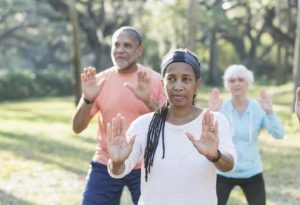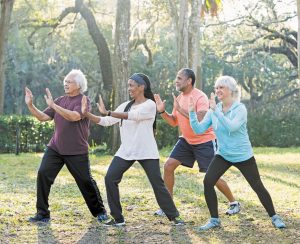Reduce Anxiety and Depression with COPD with Mind-Body practices
By John M. de Castro, Ph.D.
“We found that yoga can be a simple, cost-effective method that can help improve quality of life in patients with COPD.” – Randeep Guleria
Chronic Obstructive Pulmonary Diseases (COPD) are progressive lung diseases that obstruct airflow. The two main types of COPD are chronic bronchitis and emphysema. COPD is very serious being the third leading cause of death in the United States, over 140,000 deaths per year and the number of people dying from COPD is growing. More than 11 million people have been diagnosed with COPD, but an estimated 24 million may have the disease without even knowing it. COPD causes serious long-term disability and early death.
There is no cure for COPD. Treatments include lifestyle changes, medicine, bronchodilators, steroids, pulmonary rehabilitation, oxygen therapy, and surgery. They all attempt to relieve symptoms, slow the progress of the disease, improve exercise tolerance, prevent and treat complications, and improve overall health. Gentle mind-body exercise such as Yoga, Tai Chi and Qigong practices could improve COPD symptoms. Yoga has been shown to improve exercise tolerance and overall health and includes breathing exercises. Indeed, it has been shown that yoga practice improves the mental and physical health of patients with COPD. Mindful movement practices such Tai Chi and Qigong are ancient Chinese practices involving mindfulness and gentle movements. They are easy to learn, safe, and gentle. So, it may be appropriate for patients with COPD who lack the ability to engage in strenuous exercises to engage in these gentle mind-body practices.
In today’s Research News article “Mind-Body Exercise for Anxiety and Depression in COPD Patients: A Systematic Review and Meta-Analysis.” (See summary below or view the full text of the study at: https://www.ncbi.nlm.nih.gov/pmc/articles/PMC6981896/), Li and colleagues review, summarize, and perform a meta-analysis of the published research studies of the effectiveness of mind-body practices on the symptoms of Chronic Obstructive Pulmonary Diseases (COPD).
They found 13 peer-reviewed randomized controlled trials; 7 employing Qigong, 3 Tai Chi, and 3 yoga. They report that the published research found that mind-body practices produced significant reductions in anxiety and depression in patients with Chronic Obstructive Pulmonary Diseases (COPD).
Mindfulness practices, in general have been found to reduce anxiety and depression. The present review extends this effectiveness to mind-body mindfulness practices with patients with COPD. The mechanisms by which these practices produce these effects are not known. But all these practices involve focusing on the present moment. Anxiety is produced by fear of the future while depression is produced by rumination about the past. While focusing on the present, anxiety and depression are eliminated. Obviously, training does not eliminate thinking about the past and future. But, it may reduce the amount of time spent outside the present moment and thereby reduce the overall levels of anxiety and depression.
So, Reduce Anxiety and Depression with COPD with Mind-Body practices.
“The challenge for meditators with a history of asthma, COPD, or other breathing problems is that the seemingly simple process of breathing is entangled with fear, anxiety, and other difficult emotions.” – Susan Haejin Lee
CMCS – Center for Mindfulness and Contemplative Studies
This and other Contemplative Studies posts are also available on Google+ https://plus.google.com/106784388191201299496/posts and on Twitter @MindfulResearch
Study Summary
Li, Z., Liu, S., Wang, L., & Smith, L. (2019). Mind-Body Exercise for Anxiety and Depression in COPD Patients: A Systematic Review and Meta-Analysis. International journal of environmental research and public health, 17(1), 22. https://doi.org/10.3390/ijerph17010022
Abstract
Objectives: Mind–body exercise has been generally recognized as a beneficial strategy to improve mental health in those with Chronic Obstructive Pulmonary Disease (COPD). However, to date, no attempt has been made to collate this literature. The aim of the present study was to systematically analyze the effects of mind–body exercise for COPD patients with anxiety and depression and provide scientific evidence-based exercise prescription. Methods: both Chinese and English databases (PubMed, the Cochrane Library, EMBASE, Web of Science, Google Scholar, Chinese National Knowledge Infrastructure, Wanfang, Baidu Scholar) were used as sources of data to search randomized controlled trials (RCT) relating to mind–body exercise in COPD patients with anxiety and depression that were published between January 1982 to June 2019. 13 eligible RCT studies were finally used for meta-analysis. Results: Mind–body exercise (tai chi, health qigong, yoga) had significant benefits on COPD patients with anxiety (SMD = −0.76, 95% CI −0.91 to −0.60, p = 0.04, I2 = 47.4%) and depression (SMD = −0.86, 95% CI −1.14 to −0.58, p = 0.000, I2 = 71.4%). Sub-group analysis indicated that, for anxiety, 30–60 min exercise session for 24 weeks of health qigong or yoga had a significant effect on patients with COPD who are more than 70 years and have more than a 10-year disease course. For depression, 2–3 times a week, 30–60 min each time of health qigong had a significant effect on patients with COPD patients who are more than 70 years old and have less than a 10-year disease course. Conclusions: Mind–body exercise could reduce levels of anxiety and depression in those with COPD. More robust RCT are required on this topic.
https://www.ncbi.nlm.nih.gov/pmc/articles/PMC6981896/









